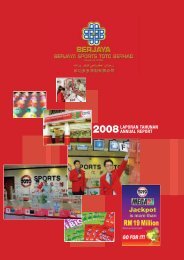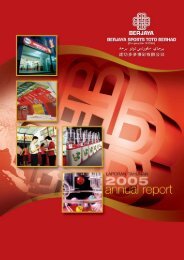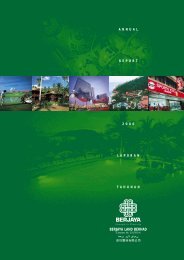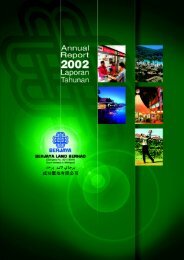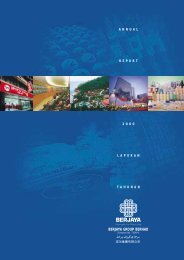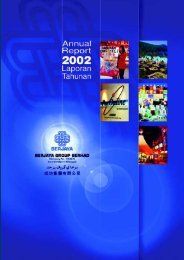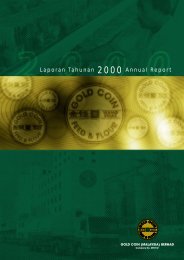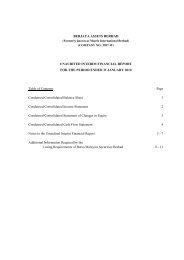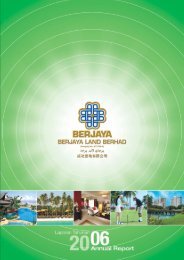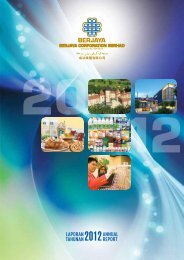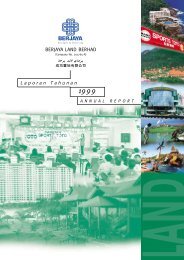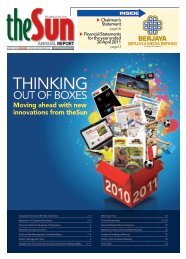Pg 147 - Berjaya Corporation Berhad
Pg 147 - Berjaya Corporation Berhad
Pg 147 - Berjaya Corporation Berhad
Create successful ePaper yourself
Turn your PDF publications into a flip-book with our unique Google optimized e-Paper software.
<strong>Berjaya</strong> Land <strong>Berhad</strong> (201765-A)<br />
52<br />
Annual Report 2005<br />
Notes To The Financial Statements<br />
30 April 2005<br />
2 SIGNIFICANT ACCOUNTING POLICIES (CONT’D)<br />
(k)<br />
Employee benefits<br />
(i) Short term benefits<br />
Wages, salaries, bonuses and social security contributions are recognised as an expense in the year in which the associated<br />
services are rendered by employees of the Group. Short term accumulating compensated absences such as paid annual<br />
leave are recognised when services are rendered by employees that increase their entitlement to future compensated<br />
absences. Short term non-accumulating compensated absences such as sick leave are recognised when the absences<br />
occur.<br />
(ii)<br />
(iii)<br />
Defined contribution plans<br />
Contributions relating to defined contribution plans are charged to the income statement when incurred. Retirement benefits for<br />
employees of foreign subsidiary companies are accrued for in accordance with the provisions of those foreign countries’<br />
retirement law and are charged to income statement in the period to which they relate.<br />
Defined benefit plans<br />
Certain subsidiary companies within the Group operate unfunded, defined benefit Retirement Benefit Schemes (“the Scheme”)<br />
for their eligible employees. The Group’s obligations under the Scheme are calculated using the Projected Unit Credit Method<br />
determined based on actuarial computations by independent actuaries, through which the amount of benefit that employees<br />
have earned in return for their service in the current and prior years is estimated. That benefit is discounted in order to<br />
determine its present value. Actuarial gains and losses are recognised as income or expense over the expected average<br />
remaining working lives of the participating employees when the cumulative unrecognised actuarial gains or losses for the<br />
Scheme exceed 10% of the present value of the defined benefits obligation. Past service costs are recognised immediately to<br />
the extent that the benefit are already vested, and otherwise is amortised on a straight-line basis over the average period until<br />
the amended benefits become vested.<br />
The amount recognised in the balance sheet represents the present value of the defined benefit obligations adjusted for<br />
unrecognised actuarial gains and losses and unrecognised past service cost.<br />
(l)<br />
Income Taxes<br />
Tax on profit or loss for the year comprises current and deferred tax. Current tax expense is the expected tax payable on the<br />
taxable income for the year, using tax rates enacted or substantively enacted at the balance sheet date, and any adjustment to tax<br />
payable in respect of the previous year.<br />
Deferred tax is provided, using the liability method, on temporary differences arising between the tax bases of assets and liabilities<br />
and their carrying amounts in the financial statements. Deferred tax is not recognised on temporary differences arising from<br />
goodwill not deductible for tax purposes and the initial recognition of assets or liabilities that at the time of transaction affects neither<br />
accounting nor taxable profit.<br />
The amount of deferred tax provided is based on the expected manner of realisation or settlement of the carrying amount of assets<br />
and liabilities, using tax rates enacted or substantively enacted at the balance sheet date.<br />
Deferred tax is recognised in the income statement except to the extent that it relates to items recognised directly in equity, in which<br />
case it is recognised in equity, or when it arises from a business combination that is an acquisition, in which case the deferred tax<br />
is included in the resulting goodwill or negative goodwill.<br />
A deferred tax asset is recognised only to the extent that it is probable that future taxable profits will be available against which the<br />
asset can be utilised.<br />
(m) Foreign Currencies<br />
Transactions in foreign currencies are recorded in Ringgit Malaysia at rates of exchange ruling at the transaction dates or, where<br />
settlement had not taken place at 30 April, at rates of exchange ruling at the date or at contracted rates, as applicable. Exchange<br />
differences arising on long term inter-company advances that, in substance, form part of an enterprise’s net investment in a foreign<br />
subsidiary are taken directly to an exchange reserve account. All other exchange differences arising are dealt with through the<br />
income statement.



